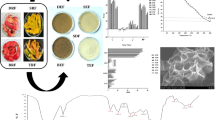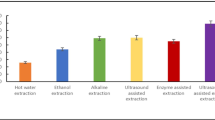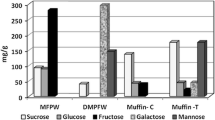Abstract
Mango is considered one of the most important tropical fruits worldwide in terms of its consumption and consumer acceptability. Its processing generates huge quantities of mango byproducts, which is often discarded unscrupulously into the environment and, therefore, needs effective waste management practices. The extraction of mango peels’ dietary fiber using enzymatic method can be a useful valorization strategy for management of mango by-products. In the present investigation, dietary fiber (soluble and insoluble fraction) was extracted by enzymatic hydrolysis using α-amylase, protease, and amyloglucosidase. Highest yield of dietary fiber (67.5%, w/w) was obtained at 60 °C temperature using recommended enzyme concentrations including α-amylase (40 µL), protease (110 µL), and amyloglucosidase (200 µL) after a treatment time of 60 min. SEM analysis indicated the increased porosity of dietary fiber samples caused due to the hydrolytic effect of enzymes on its surface structure, whereas FTIR analysis confirmed the functional groups present in dietary fiber. The coexistence of crystalline and amorphous nature of polymers present in soluble and insoluble fractions of dietary fiber was assessed by XRD analysis. Further, the analysis of functional properties including WHC, OHC, and SC revealed the suitability of using extracted mango peel’s dietary fiber in the food systems.






Similar content being viewed by others
Data availability
All data generated or analyzed during this study are included in this published article.
References
Ajila C, Bhat S, Rao UP (2007) Valuable components of raw and ripe peels from two Indian mango varieties. Food Chem 102:1006–1011. https://doi.org/10.1016/j.foodchem.2006.06.036
Ajila CM, Rao UP (2013) Mango peel dietary fibre: composition and associated bound phenolics. JFF 5(1):444–450. https://doi.org/10.1016/j.jff.2012.11.017
Al-Sheraji SH, Ismail A, Manap MY, Mustafa S, Yusof RM, Hassan FA (2012) Purification, characterization and antioxidant activity of polysaccharides extracted from the fibrous pulp of Mangifera pajang fruits. LWT 48(2):291–296
Babbar N, Roy SV, Wijnants M, Dejonghe W, Caligiani A, Sforza S, Elst K (2016) Effect of extraction conditions on the saccharide (neutral and acidic) composition of the crude pectic extract from various agro-industrial residues. J Agric Food Chem 64(1):268–276. https://doi.org/10.1021/acs.jafc.5b04394
Bayar N, Friji M, Kammoun R (2018) Optimization of enzymatic extraction of pectin from Opuntia ficus indica cladodes after mucilage removal. Food Chem 241:127–134. https://doi.org/10.1016/j.foodchem.2017.08.051
Behrouzian F, Amini AM, Alghooneh A, Razavi SMA (2016) Characterization of dietary fiber from coffee silverskin: an optimization study using response surface methodology. Bioact Carbohydr Diet Fibre 8(2):58–64. https://doi.org/10.1016/j.bcdf.2016.11.004
Beretta MV, Bernaud FR, Nascimento C, Steemburgo T, Rodrigues TC (2018) Higher fiber intake is associated with lower blood pressure levels in patients with type 1 diabetes. Arch Endocrinol Metab 62(1):47–54. https://doi.org/10.20945/2359-3997000000008
Castro-Vargas HI, Ballesteros Vivas D, Ortega Barbosa J et al (2019) Bioactive phenolic compounds from the agroindustrial waste of Colombian mango cultivars ‘sugar mango’ and ‘tommy atkins’- an alternative for their use and valorization. Antioxidants 8(2):41. https://doi.org/10.3390/antiox8020041
Chen H, Xiong M, Bai T, Chen D, Zhang Q, Lin D, Liu Y, Liu A, Huang Z, Qin W (2021) Comparative study on the structure, physicochemical, and functional properties of dietary fiber extracts from quinoa and wheat. LWT 149:111816. https://doi.org/10.1016/j.lwt.2021.111816
Chen H, Zhao C, Jie L, Hussain S, Yan S, Wang Q (2018) Effects of extrusion on structural and physicochemical properties of soluble dietary fiber from nodes of lotus root. LWT 93:204–211
Cheng L, Zhang X, Hong Y, Li Z, Li C, Gu Z (2017) Characterisation of physicochemical and functional properties of soluble dietary fibre from potato pulp obtained by enzyme-assisted extraction. Int J Biol Macromol 101:1004–1011
Cheng Z, Song H, Yang Y, Liu Y, Liu Z, Hu H, Zhang Y (2015) Optimization of microwave-assisted enzymatic extraction of polysaccharides from the fruit of Schisandra chinensis Baill. Int J Biol Macromol 76:161–168. https://doi.org/10.1016/j.ijbiomac.2015.01.048
Dreher ML (2018) Overview of the health benefits of adequate fiber intake. Nutr Health 19–40. https://doi.org/10.1007/978-3-319-50557-2_2.
Dudonne S, Vitrac X, Coutiere P, Woillez M, Merillon JM (2009) Comparative study of antioxidant properties and total phenolic content of 30 plant extracts of industrial interest using DPPH, ABTS, FRAP, SOD, and ORAC assay. J Agric Food Chem 57(5):1768–1774. https://doi.org/10.1021/jf803011r
Elleuch M, Bedigian D, Roiseux O, Besbes S, Blecker C, Attia H (2011) Dietary fibre and fibre-rich by-products of food processing: Characterisation, technological functionality and commercial applications: a review. Food Chem 124(2):411–421. https://doi.org/10.1016/j.foodchem.2010.06.077
FAO (2010) Joint FAO/WHO food standards programme CODEX alimentarius commission codex alimentarius (CODEX) guidelines on nutrition labelling CAC/GL 2–1985 as last amended 2010. FAO, Rome, Italy
Gamel TH, Abdel-Aal ESM, Ames NP, Duss R, Tosh SM (2014) Enzymatic extraction of beta-glucan from oat bran cereals and oat crackers and optimization of viscosity measurement. J Cereal Sci 59:33–40. https://doi.org/10.1016/j.jcs.2013.10.011
Gan J, Huang Z, Yu Q, Peng G et al (2020) Microwave assisted extraction with three modifications on structural and functional properties of soluble dietary fibers from grapefruit peel. Food Hydrocoll 101:105549. https://doi.org/10.1016/j.foodhyd.2019.105549
Hasnaoui N, Wathelet B, Jiménez-Araujo A (2014) Valorization of pomegranate peel from 12 cultivars: dietary fibre composition, antioxidant capacity and functional properties. Food Chem 160:196–203. https://doi.org/10.1016/j.foodchem.2014.03.089
Hassan Z, Imran M, Ahmad MH, Khan MK (2021) Ultrasound-assisted modification of insoluble dietary fiber from chia (Salvia hispanica L.) seeds. J Food Qual 2021:1–10. https://doi.org/10.1155/2021/5035299
He Y, Li W, Zhang X, Li T, Ren D, Lu J (2020) Physicochemical, functional, and microstructural properties of modified insoluble dietary fiber extracted from rose pomace. J Food Sci Technol 57:1421–1429. https://doi.org/10.1007/s13197-019-04177-8
Hu H, Zhao Q (2018) Optimization extraction and functional properties of soluble dietary fiber from pineapple pomace obtained by shear homogenization-assisted extraction. RSC Adv 8(72):41117–41130. https://doi.org/10.1039/C8RA06928J
Inglett GE (1993) Amylodextrins containing β-glucan from oat flours and bran. Food Chem 47:133–136. https://doi.org/10.1016/0308-8146(93)90234-7
Izidoro M, Leonel M, Leonel S, Lossoli NAB, Cândido HT, Züge PGU, Assis JLDJ (2023) Nutritional and technological properties of pulp and peel flours from different mango cultivars. Food Sci Technol 43. https://doi.org/10.1590/fst.107922
Jeong HS, Kim HY, Ahn SH et al (2014) Optimization of enzymatic hydrolysis conditions for extraction of pectin from rapeseed cake (Brassica napus L.) using commercial enzymes. Food Chem 157:332–338. https://doi.org/10.1016/j.foodchem.2014.02.040
Jiang Y, Lawrence M, Ansell MP, Hussain A (2018) Cell wall microstructure, pore size distribution and absolute density of hemp shiv. R Soc Open Sci 5(4):171945. https://doi.org/10.1098/rsos.171945
Karaman E, Yılmaz E, Tuncel NB (2017) Physicochemical, microstructural and functional characterization of dietary fibers extracted from lemon, orange and grapefruit seeds press meals. Bioact Carbohydr 11:9–17. https://doi.org/10.1016/j.bcdf.2017.06.001
Karimi R, Azizi MH, Xu Q, Sahari MA, Hamidi Z (2018) Enzymatic removal of starch and protein during the extraction of dietary fiber from barley bran. J Cereal Sci 83:259–265. https://doi.org/10.1016/j.jcs.2018.07.012
Kaur B, Panesar PS, Anal AK, Chu-Ky S (2022) Recent trends in the management of mango by-products. Food Rev Int 1–21. https://doi.org/10.1080/87559129.2021.2021935.
Kaur B, Panesar PS, Thakur A (2021) Extraction and evaluation of structural and physicochemical properties of dietary fiber concentrate from mango peels by using green approach. Biomass Convers Biorefin 1–10. https://doi.org/10.1007/s13399-021-01740-2.
Li Q, Yang S, Li Y, Huang Y, Zhang J (2019) Antioxidant activity of free and hydrolyzed phenolic compounds in soluble and insoluble dietary fibres derived from hulless barley. LWT 111:534–540. https://doi.org/10.1016/j.lwt.2019.05.086
Ling Z, Chen S, Zhang X, Takabe K, Xu F (2017) Unraveling variations of crystalline cellulose induced by ionic liquid and their effects on enzymatic hydrolysis. Sci Rep 7(1):10230–10230
Liu YL, Zhang HB, Yi CP, Quan K, Lin BP (2021) Chemical composition, structure, physicochemical and functional properties of rice bran dietary fiber modified by cellulase treatment. Food Chem 342:128352. https://doi.org/10.1016/j.foodchem.2020.128352
López-Vargas JH, Fernández-López J, Pérez-Álvarez JA, Viuda-Martos M (2013) Chemical, physico-chemical, technological, antibacterial and antioxidant properties of dietary fiber powder obtained from yellow passion fruit (Passiflora edulis var. flavicarpa) co-products. Food Res Int 51(2):756–763
Ragoubi M (2010) Contribution to improving natural fiber/thermoplastic matrix interfacial compatibility via corona discharge treatment. Doctoral dissertation, Nancy 1
Ma M, Mu T, Sun H, Zhang M, Chen J, Yan Z (2015) Optimization of extraction efficiency by shear emulsifying assisted enzymatic hydrolysis and functional properties of dietary fiber from deoiled cumin (Cuminum cyminum L.). Food Chem 179:270–277. https://doi.org/10.1016/j.foodchem.2015.01.136
Ma MM, Mu TH (2016) Effects of extraction methods and particle size distribution on the structural, physicochemical, and functional properties of dietary fiber from deoiled cumin. Food Chem 194:237–246
Margareta E and Nyman GL (2002) Modification of physicochemical properties of dietary fiber of carrots by mono-and divalent cations. Food Chem 273–280. https://doi.org/10.1016/S0308-8146(01)00271-0.
Ma Q, Ma Z, Wang W, Mu J et al (2022) The effects of enzymatic modification on the functional ingredient-dietary fiber extracted from potato residue. LWT 153:112511. https://doi.org/10.1016/j.lwt.2021.112511
Moczkowska M, Karp S, Niu Y, Kurek MA (2019) Enzymatic, enzymatic-ultrasonic and alkaline extraction of soluble dietary fibre from flaxseed–a physicochemical approach. Food Hydrocoll 90:105–112. https://doi.org/10.1016/j.foodhyd.2018.12.018
Nadar SS, Rao P, Rathod VK (2018) Enzyme assisted extraction of biomolecules as an approach to novel extraction technology: a review. Food Res Int 108:309–330. https://doi.org/10.1016/j.foodres.2018.03.006
Niu Y, Li N, Xia Q, Hou Y, Xu G (2018) Comparisons of three modifications on structural, rheological and functional properties of soluble dietary fibers from tomato peels. LWT 88:56–63. https://doi.org/10.1016/j.lwt.2017.10.003
Pavel S, Klejdus B, Kuban V (2006) Determination of total content of phenolic compounds and their antioxidant activity in vegetables evaluation of spectrophotometric methods. J Agric Food Chem 54:607–616. https://doi.org/10.1021/jf052334j
Peerajit P, Chiewchan N, Devahastin S (2012) Effects of pretreatment methods on health-related functional properties of high dietary fibre powder from lime residues. Food Chem 132(4):1891–1898. https://doi.org/10.1016/j.foodchem.2011.12.022
Peterson ME, Daniel RM, Danson MJ, Eisenthal R (2007) The dependence of enzyme activity on temperature: determination and validation of parameters. Biochem J 402(2):331–337. https://doi.org/10.1042/BJ20061143
Plakantonaki S, Roussis I, Bilalis D, Priniotakis G (2023) Dietary fiber from plant-based food wastes: a comprehensive approach to cereal, fruit, and vegetable waste valorization. Processes 11:1580. https://doi.org/10.3390/pr11051580
Plakantonaki S, Stergiou M, Panagiotatos G, Kiskira K, Priniotakis G (2022) Regenerated cellulosic fibers from agricultural waste. AIP Conf Proc 2430(1):080006. https://doi.org/10.1063/5.0077088
Prosky L, Asp NG, Schweizer T, Devries J, Furda I (1988) Determination of insoluble, soluble, and total dietary fiber in foods and food products: interlaboratory study. J Assoc Off Analytic Chem 71(5):1017–1023. https://doi.org/10.1093/jaoac/71.5.1017
PrzybyszBuzała K, Przybysz P, Kalinowska H, Derkowska M (2016) Effect of cellulases and xylanases on refining process and kraft pulp properties. PLoS One 11(8):e0161575–e0161575
Qi B, Jiang L, Li Y, Chen S, Sui X (2011) Extract dietary fiber from the soy pods by chemistry-enzymatic methods. Procedia Eng 15:4862–4873. https://doi.org/10.1016/j.proeng.2011.08.907
Ramaswamy UR, Kabel MA, Schols HA, Gruppen H (2013) Structural features and water holding capacities of pressed potato fibre polysaccharides. Carbohydr Polym 93(2):589–596
Rifna EJ, Misra NN, Dwivedi M (2021) Recent advances in extraction technologies for recovery of bioactive compounds derived from fruit and vegetable waste peels: a review. Crit Rev Food Sci Nutr 63(6):719–752. https://doi.org/10.1080/10408398.2021.1952923
Rouhou MC, Abdelmoumen S, Thomas S, Attia H, Ghorbel D (2018) Use of green chemistry methods in the extraction of dietary fibers from cactus rackets (Opuntia ficus indica): structural and microstructural studies. Int J Biol Macromol 116:901–910. https://doi.org/10.1016/j.ijbiomac.2018.05.090
Safdar MN, Kausar T, Nadeem M, Murtaza M, Sohail S, Mumtaz A et al (2021) Extraction of phenolic compounds from (Mangifera indica L.) and kinnow (Citrus reticulate L.) peels for the development of functional fruit bars. Food Sci Technol 42:e09321. https://doi.org/10.1590/fst.09321
Salehifar M, Fadaei V (2011a) Comparison of some functional properties and chemical constituents of dietary fibers of Iranian rice bran extracted by chemical and enzymatic methods. Afr J Biotechnol 10(80):18528–18531. https://doi.org/10.5897/AJB11.956
Salehifar M, Fadaei V (2011b) Comparison of some functional properties and chemical constituents of dietary fibers of Iranian rice bran extracted by chemical and enzymatic methods. AJB 10(80):18528–18531. https://doi.org/10.5897/AJB11.956
Sang J, Li L, Wen J, Gu Q et al (2021) Evaluation of the structural, physicochemical and functional properties of dietary fiber extracted from Newhall navel orange by-products. Foods 10(11):2772. https://doi.org/10.3390/foods10112772
Santala O, Kiran A, Sozer N, Poutanen K, Nordlund E (2014) Enzymatic modification and particle size reduction of wheat bran improves the mechanical properties and structure of bran-enriched expanded extrudates. J Cereal Sci 60:448–456. https://doi.org/10.1016/j.jcs.2014.04.003
Sciarini LS, Maldonado F, Ribotta PD, Pérez GT, León AE (2009) Chemical composition and functional properties of Gleditsia triacanthos gum. Food Hydrocoll 23(2):306–313. https://doi.org/10.1016/j.foodhyd.2008.02.011
Serna-Cock L, García-Gonzales E, Torres-Leon C (2016) Agroindustrial potential of the mango peels based on its nutritional and functional properties. Food Rev Int 32(4):364–376. https://doi.org/10.1080/87559129.2015.1094815
Sogi D, Siddiq M, Greiby I, Dolan K (2013) Total phenolics, antioxidant activity, and functional properties of ‘Tommy Atkins’ mango peels and kernel as affected by drying methods. Food Chem 141(3):2649–2655. https://doi.org/10.1016/j.foodchem.2013.05.053
Tejada-Ortigoza V, Garcia-Amezquita LE, Serna-Saldivar SO, Welti-Chanes J (2016) Advances in the functional characterization and extraction processes of dietary fiber. Food Eng Rev 8(3):251–271. https://doi.org/10.1007/s12393-015-9134-y
Wang J, Sun B, Liu Y, Zhang H (2014) Optimisation of ultrasound-assisted enzymatic extraction of arabinoxylan from wheat bran. Food Chem 150:482–488. https://doi.org/10.1016/j.foodchem.2013.10.121
Wang K, Li M, Wang Y, Liu Z, Ni Y (2021) Effects of extraction methods on the structural characteristics and functional properties of dietary fiber extracted from kiwifruit (Actinidia deliciosa). Food Hydrocoll 110:106162. https://doi.org/10.1016/j.foodhyd.2020.106162
Wang L, Xu H, Yuan F, Fan R, Gao Y (2015) Preparation and physicochemical properties of soluble dietary fiber from orange peel assisted by steam explosion and dilute acid soaking. Food Chem 185:90–98. https://doi.org/10.1016/j.foodchem.2015.03.112
Wen L, Zhang Z, Zhao M, Senthamaraikannan R, Padamati RB, Sun DW, Tiwari BK (2020) Green extraction of soluble dietary fibre from coffee silverskin: impact of ultrasound/microwave-assisted extraction. Int J Food Sci 55(5):2242–2250. https://doi.org/10.1111/ijfs.14477
Yan X, Ye R, Chen Y (2015) Blasting extrusion processing: the increase of soluble dietary fiber content and extraction of soluble-fiber polysaccharides from wheat bran. Food Chem 180:106–115
Zhang M, Bai X, Zhang Z (2011) Extrusion process improves the functionality of soluble dietary fiber in oat bran. J Cereal Sci 54:98–103. https://doi.org/10.1016/j.jcs.2011.04.001
Zheng Y, Liu S, Xie J, Chen Y, Dong R, Zhang X, Liu S, Xie J, Hu X, Yu Q (2020) Antioxidant, α-amylase and α-glucosidase inhibitory activities of bound polyphenols extracted from mung bean skin dietary fiber. LWT 132:109943. https://doi.org/10.1016/j.lwt.2020.109943
Zhao G, Zhang R, Dong L et al (2018) A Comparison of the chemical composition, in vitro bioaccessibility and antioxidant activity of phenolic compounds from rice bran and its dietary fibres. Molecules 23(1):202. https://doi.org/10.3390/molecules23010202
Acknowledgements
The infrastructural support provided by Sant Longowal Institute of Engineering and Technology (SLIET), for carrying out the research is acknowledged.
Funding
The research project was funded by ASEAN India Science & Technology Development Fund (AISTDF), Science & Engineering Research Board, Department of Science & Technology (SERB-DST) under Grant No. CRD/2019/000141.
Author information
Authors and Affiliations
Contributions
All authors contributed to the study conception and design. Investigation, methodology, writing- original draft, and formal analysis were done by BK. Conceptualization, writing — review and editing, supervision, and project administration were done by PSP. Interpretation of data and cosupervision of the investigation were done by AT. All authors read and approved the final manuscript.
Corresponding author
Ethics declarations
Ethics approval
Not applicable.
Consent for publication
Not applicable.
Competing interests
The authors declare no competing interests.
Additional information
Responsible Editor: Ta Yeong Wu
Publisher's Note
Springer Nature remains neutral with regard to jurisdictional claims in published maps and institutional affiliations.
Rights and permissions
Springer Nature or its licensor (e.g. a society or other partner) holds exclusive rights to this article under a publishing agreement with the author(s) or other rightsholder(s); author self-archiving of the accepted manuscript version of this article is solely governed by the terms of such publishing agreement and applicable law.
About this article
Cite this article
Kaur, B., Panesar, P.S. & Thakur, A. Biovalorization of mango byproduct through enzymatic extraction of dietary fiber. Environ Sci Pollut Res (2023). https://doi.org/10.1007/s11356-023-31450-3
Received:
Accepted:
Published:
DOI: https://doi.org/10.1007/s11356-023-31450-3




